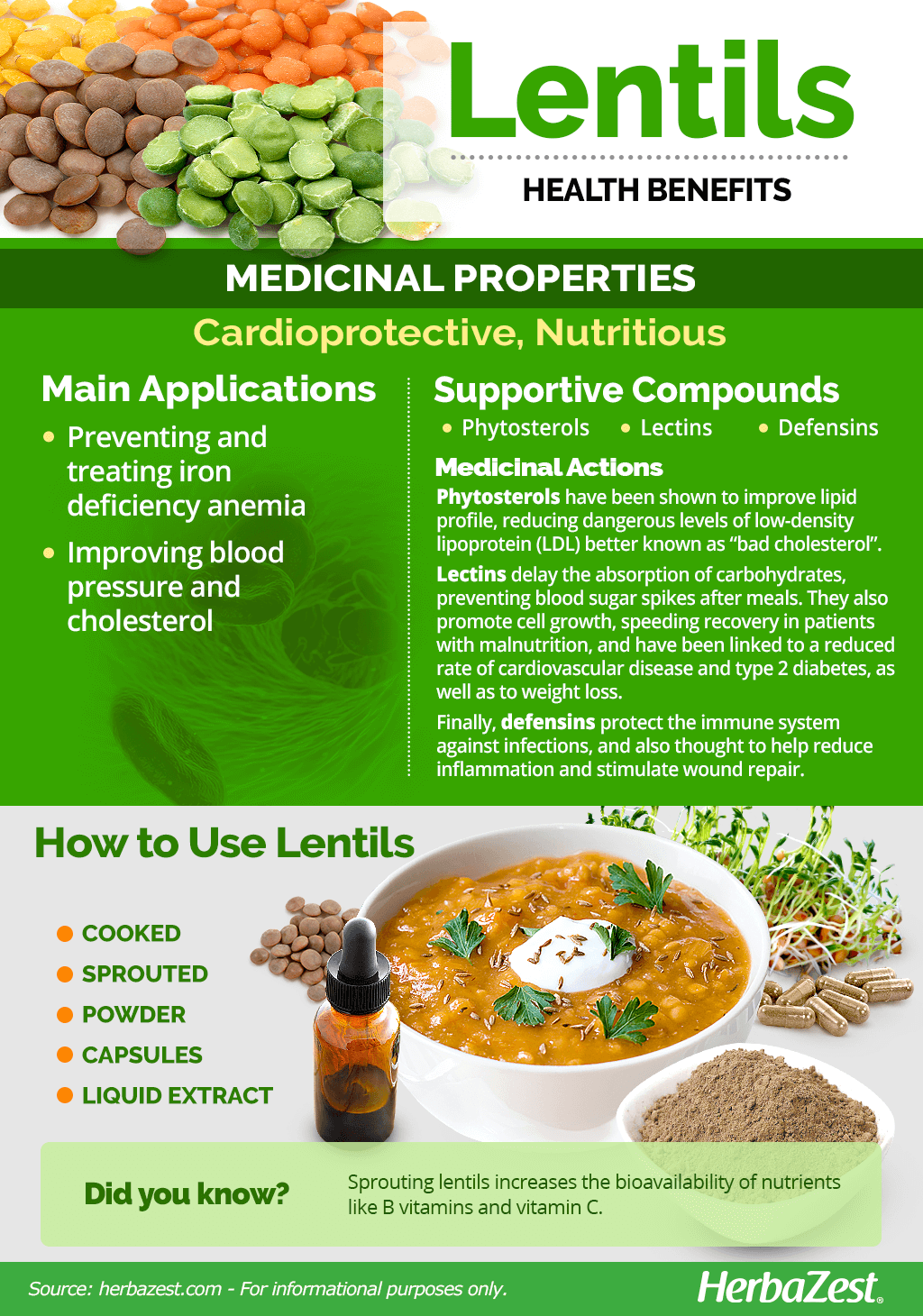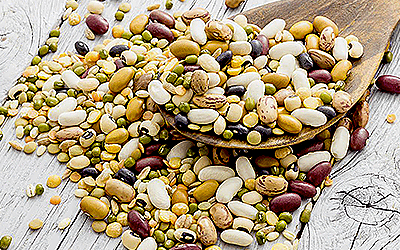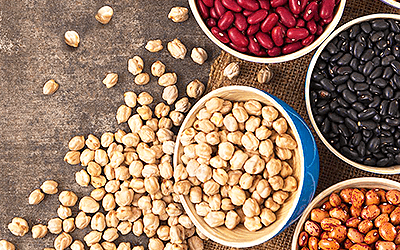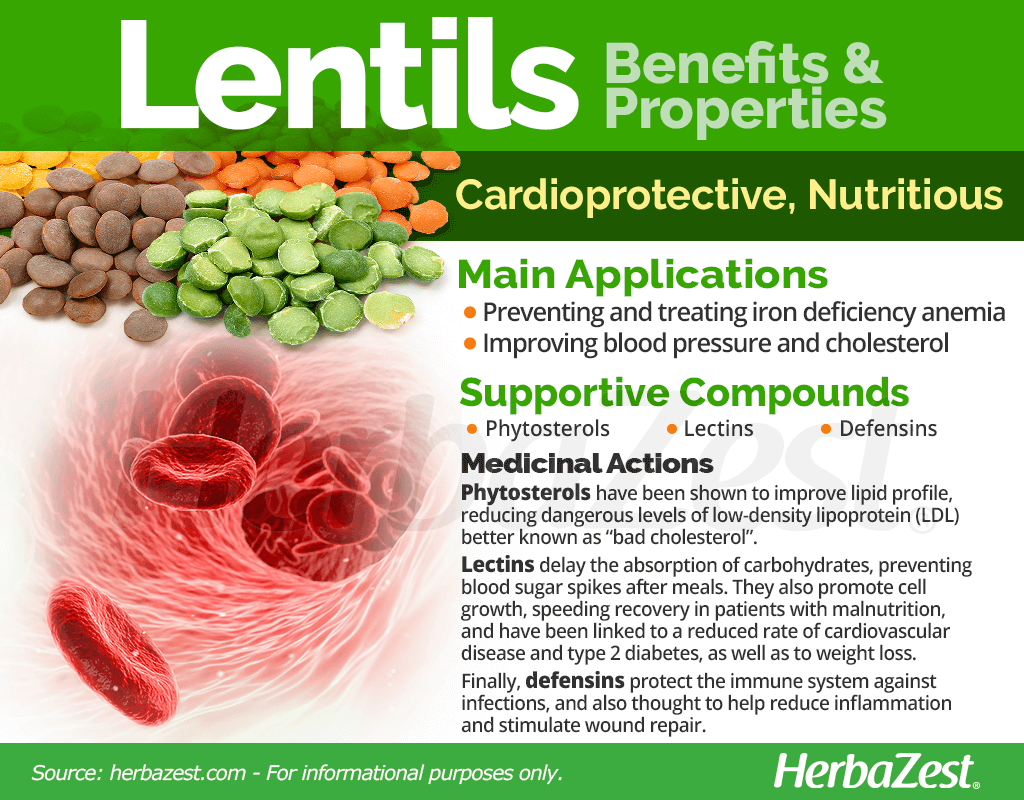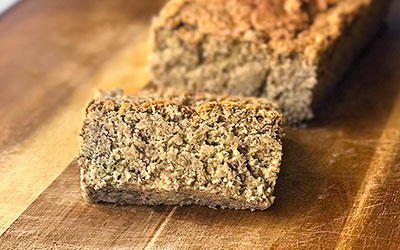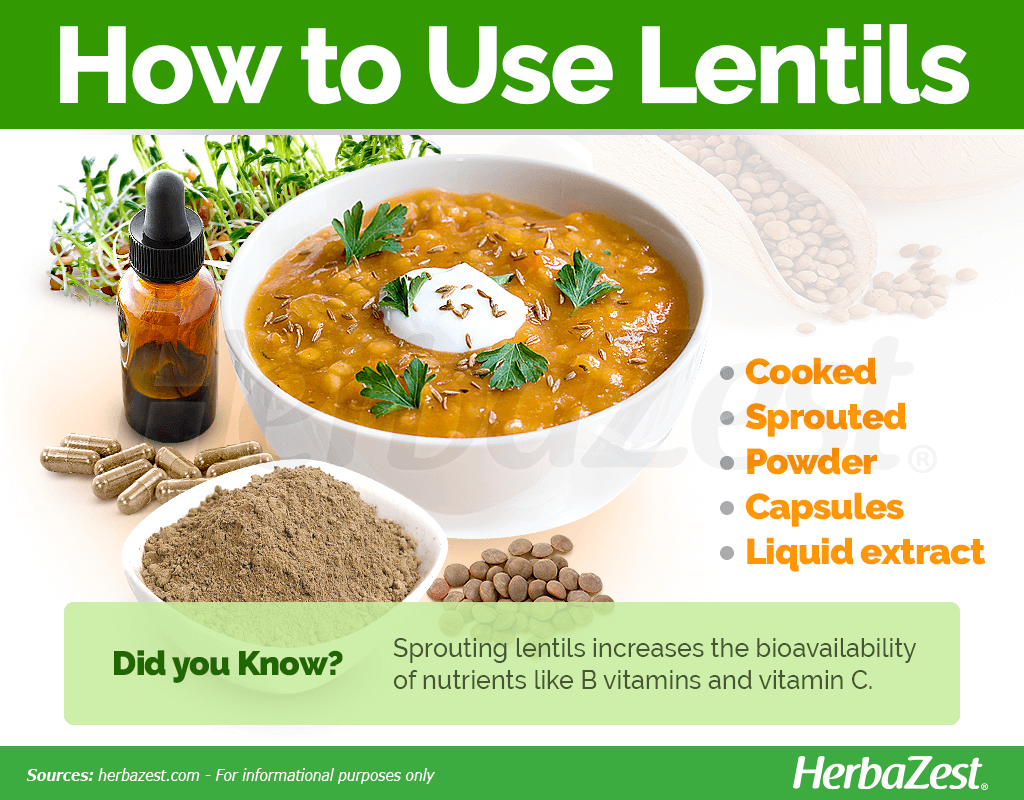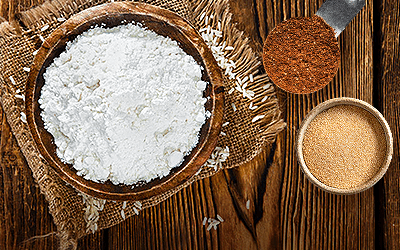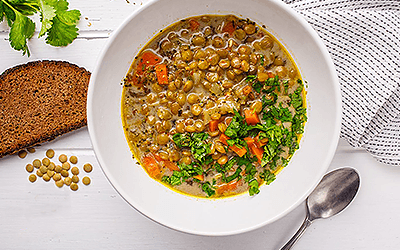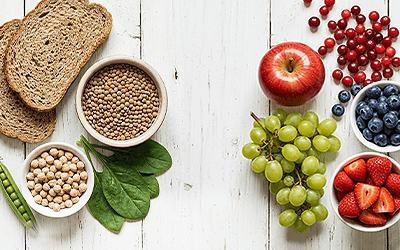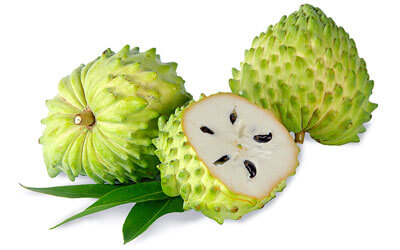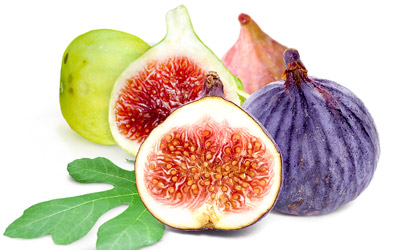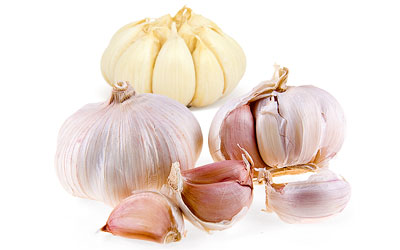While the lentil plant is thought to be indigenous to southwestern Asia, it is nowadays widely cultivated throughout the globe and consumed in virtually every household as part of a balanced diet. However, the humble lentils are not just an incredible powerhouse of nutrition but also a source of medicinal benefits.
Lentil Medicinal Properties
Health Benefits of Lentils
Lentils have been consumed since the dawn of civilization and are well known for their nutritional richness. However, modern scientific research has shed light on lentils' properties as a functional food. So far, these are the main lentils' benefits for human health:
Preventing and treating iron deficiency anemia. Consuming lentils is an excellent way of ensuring healthy iron levels since the deficiency of this essential mineral is the most common cause of anemia worldwide.
Improving blood pressure and cholesterol. Consuming lentils as part of a healthy diet has proven to stabilize blood pressure and reduce harmful levels of LDL cholesterol, thus preventing cardiovascular disease.
Lowering blood sugar. Lentils have been shown to delay sugar absorption in the blood stream, thus preventing sugar pikes after meals and aiding glucose control in diabetics.
Studies suggest that adding lentils to a balanced diet can help treating and preventing chronic conditions, such as metabolic syndrome, diabetes, and cardiovascular diseases. Additionally, lentils' prebiotic activity has proven useful for preventing digestive diseases.
How It Works
The main bioactive compounds responsible for lentils' health benefits are phytosterols, lectins, and defensins.1
Phytosterols are plant-derived compounds similar to cholesterol in their structure. When consumed on a daily basis from various sources, phytosterols have been shown to improve lipid profile, reducing dangerous levels of low-density lipoprotein (LDL), better known as “bad cholesterol.” The main phytosterols in lentils are b-sitosterol, campesterol, and stigmasterol.
THE RECOMMENDED DAILY INTAKE OF 2 G OF PHYTOSTEROLS REDUCES CHOLESTEROL ABSORPTION BY 30-40% AND LDL CHOLESTEROL BY 10% ON AVERAGE.2
On the other hand, lectins are a type of proteins with antioxidant properties that also delay the absorption of carbohydrates, thus preventing blood sugar spikes after meals. Lectins can also promote cell growth, which accelerates recovery in patients with malnutrition. Lectins-rich foods have been linked to a reduced rate of cardiovascular disease and type 2 diabetes as well as weight loss.
Finally, defensins are antimicrobial peptides with the ability of protecting the immune system against infections.3 They are also thought to play an important role in reducing inflammation as well as in wound repair.
Lentils are also rich in phenolic acids and flavonoids, both of which exert strong antioxidant activities that protect cellular integrity.4
Other herbs with cardioprotective properties, traditionally used for regulating blood pressure and lowering cholesterol, are garlic, hibiscus, and oats, whereas cinnamon, lucuma and lupin have been shown to prevent blood sugar spikes after meals.
Lentils Cautions
In low amounts, lectins are effective for controlling blood sugar by delaying carbohydrate absorption; however, they can be toxic when lentils are consumed raw, causing stomach discomfort, nausea, vomiting, diarrhea, and flatulence.
Lectins are also considered anti-nutrients because of their ability to inhibit the absorption of minerals such as calcium, iron, phosphorus, and zinc. Care must be taken to properly cook lentils in order to avoid this uncomfortable side effects.
- Medicinal action Cardioprotective, Nutritious
- Key constituents Fitosterols, lectins, and defensins
- Ways to use Capsules, Liquid extracts, Food, Powder
- Medicinal rating (3) Reasonably useful plant
- Safety ranking Safe
Lentil Nutrition
Lentils are a great source of dietary fiber, but also provide a wide range of nutrients, such as carbohydrates, protein, minerals, and vitamins.
The most abundant nutrient in lentils is vitamin B9, better known as folate, a nutrient that plays an essential role in brain development and fetal growth. It is also crucial for other bodily functions, such as protein metabolism, red blood cell production, and the formation of DNA and RNA.
Lentils are a source of vitamin B3 (pantothenic acid), a precursor of coenzyme A, which is essential for the biological activity of many proteins, including the one that is involved in fatty acid metabolism. Some scientific findings suggest that pantothenic acid might also improve wound healing processes. Additionally, these nutritious legumes provide good amounts of other B vitamins, mainly B1 (thiamin), B3 (niacin) and B6 (pyridoxine).
As other legumes, lentils are rich in essential minerals, mainly copper, necessary for iron absorption and hemoglobin production; manganese, for bone formation and proper wound healing; and iron, crucial for the formation of blood cells as well as for treating and preventing anemia.
Lentils also provide good amounts of phosphorus, a major bone component, and zinc, a trace mineral that supports a healthy immune system, but also plays an important role in DNA formation, cellular growth, protein synthesis, and tissue regeneration.
100 GRAMS OF COOKED LENTILS PROVIDE 116 CALORIES, WHICH ARE MAINLY COMPOSED OF DIETARY FIBER (32% DV), PROTEIN (18% DV), AND CARBOHYDRATES (7% DV).
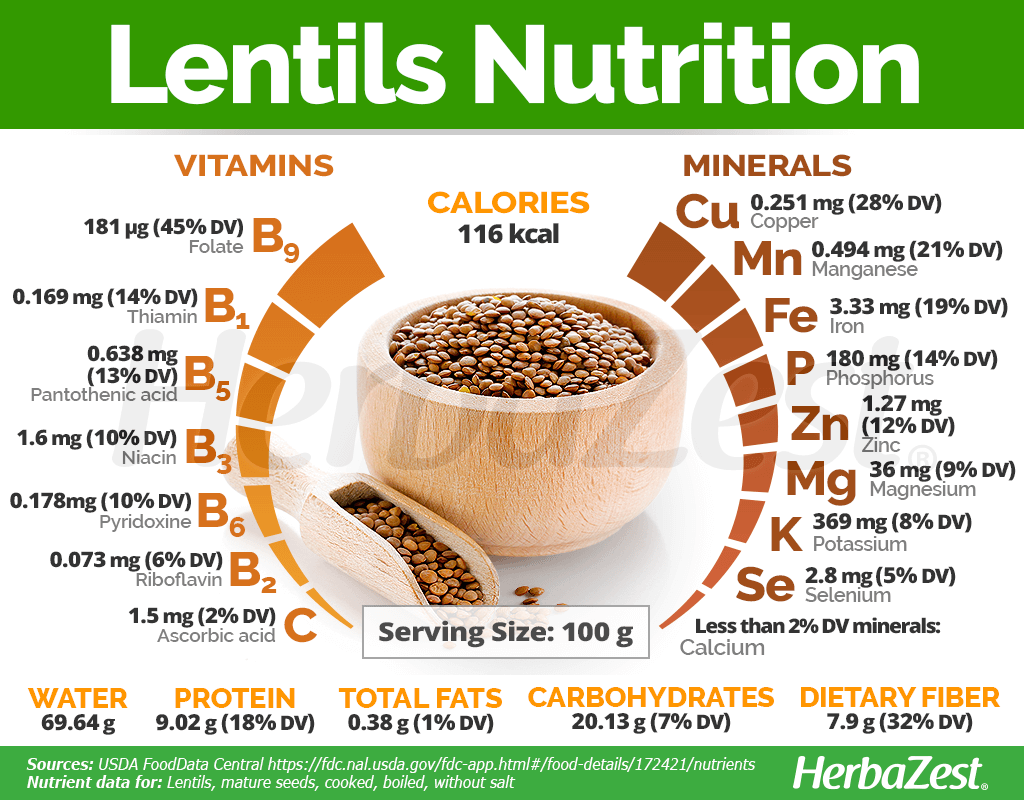
How to Consume Lentil
Natural forms
Cooked. Once cooked, lentils can be consumed in a wide variety of culinary recipes, from stews to vegan burgers and salads. They are an excellent source of protein, fiber, and other essential nutrients, such as iron, copper, manganese, and folate.
Sprouted. Sprouted lentils have become very popular for being particularly rich in nutrients and easy to digest as sprouting increases the bioavailability of vitamins B and C. They can be consumed in salads or as a crunchy addition to a sandwich.
Powder. Because of its concentration of protein and other essential nutrients, lentil powder is a popular ingredient that can be used to make creamy soups or add nutritional value to baked goods and desserts.
Herbal Remedies & Supplements
Liquid extract. Usually obtained from dry red lentils, this herbal remedy is believed to provide antihypertensive and antioxidant benefits.5,6 It is recommended to dilute 20 to 30 drops in a glass of water or juice, up to four times a day.
Capsules. Lentil extract can also be taken in capsule form, which allows for an easy ingestion with the same benefits.
- Edible parts Seed
- Edible uses Curdling agent, Protein
- Taste Acrid, Mild
Growing
Lentil plants are slender, semi-erect annuals that can grow 12-18 inch (31-46 cm) tall or more, depending on weather conditions, such as temperature, humidity, and fertility of the soil. Lentils are fairly easy to cultivate as long as some basic requirements are met.
Growing Guidelines
Lentil plants can thrive in all types of soil as long as they have a good drainage system. However, they do best on deep, sandy loam soils that are high in phosphorus and potassium and have a pH of 5.5 to 7.
Lentils are a drought-tolerant, cool-season crop that requires a minimum of 10 inches (25 cm) of annual rainfall for optimal growth.
Lentils can be planted directly or previously germinated indoors. If sowing in soil where no other legumes have previously grown and fixate atmospheric nitrogen, lentil seeds should be inoculated with Rhizobium leguminosarum bacteria at least 24 hours before planting. Lentils should be planted in late April to early May.
A firm, smooth seedbed with most of the previous crop residue incorporated is best for lentils; they should be planted at a depth of 1 to 2 inches (2.5 - 5 cm), in rows of 6 to 12 inches (15 - 30.5 cm).
The first weeks after planting are critical for the young lentil plants. Careful weed management is necessary since these legumes do not compete well with weeds.
Lentil plants typically bloom in about two months and will be ready to harvest three to four months after planting.
The most common pests that attack lentil plants are insects, mostly aphids, maggots, worms, and grasshoppers. Lentils are also susceptible to diseases, such as viruses, root rot, rust, blight, anthracnose, and seedborne fungi.
- Life cycle Annual
- Harvested parts Seeds, Shoot
- Light requirements Full sun
- Soil Loamy sand, Well-drained
- Soil pH 5.6 – 6.0 (Moderately acidic), 6.1 – 6.5 (Slightly acidic), 6.6 – 7.3 (Neutral)
- Growing habitat Cool temperate regions, Temperate climates
- Pre-germination seed treatment Rhizobia inoculation
- Planting time Spring
- Plant spacing average 0.3 m (0.98 ft)
- Growing time 3-4 months
- Potential insect pests Aphids, Bugs, Insects, Cutworms, Grasshoppers
- Potential diseases Fungi, Root rot, Rust, Viruses, Anthracnose
Additional Information
Plant Biology
The lentil plant (Lens culinaris) is a 12 to 18-inch (31-46 cm) high, low, bushy, semi-erect annual leguminous plant with many soft, hairy branches, compound leaves, and numerous oval leaflets. Lentil flowers can be white, lilac, or pale blue. The broad, smooth pods are only half an inch (1.27 cm) long. Each pod bears two seeds, which are thin, lens-shaped, usually smaller than a pea seed, and come in different colors, most commonly brown, yellow and red. A pound of dry lentils contains 6,000-12,000 seeds.
Classification
With unassuming flowers and flattened seeds, the genus Lens belongs to the Fabaceae family, which comprises 700 genera and about 17,000 species, including economically important crops such as alfalfa (Medicago sativa), bean (Phaseolus vulgaris), carob (Ceratonia siliqua), fenugreek (Trigonella foenum-graecum), licorice (Glycyrrhiza glabra), pea (Pisum sativum), chickpea (Cicer arietinum), lupine (Lupinus spp.), peanut (Arachis hypogaea), soy (Glycine max), tamarind (Tamarindus indica), and winged bean (Psophocarpus tetragonolobus).
Species and Cultivars of Lentils
Lentil (Lens culinaris) belongs to a small genus of annual plants that comprises seven species, from which a large number of hybrids have been created. The most commonly occurring and commercialized types of lentils are brown, yellow, and red.
Historical Information
Lentils have been cultivated across the Eastern side of the Mediterranean Basin, also known as the Fertile Crescent, since the Neolithic. Seeds are reported to have been found in in archeological sites along the Iberian Peninsula and also in Egyptian tombs of the 12th dynasty (2400 BCE).
Lentil cultivation, including hybridization in order to create new varieties of this cool-season annual crop, had spread from the Near East to the Mediterranean area, Asia, Europe and finally the Western Hemisphere. Lentils were introduced to the United States in the early 1900s.
Popular Beliefs
Lentils have been a staple for the human diet since the dawn of the civilization, and their presence is ubiquitous across the very first known written records, particularly in the Old Testament where lentils are associated with prosperity.
As part of their mourning rituals, ancient Romans offered to the Manes of the dead (gods of the underworld) a meal of eggs, lentils, and salt on the ninth day after a burial, at which point the mourning was ended.
Economic Data
Lentils are currently cultivated in 53 countries around the world. Major producers are Canada, India, Turkey, Australia, and the United States. In the United States, Montana, North Dakota, Washington, and Idaho lead production.
Other Uses of Lentils
Fodder. Because of their high protein content and easy digestion, lentils are often used as livestock feed.
Fertilizer. Due to their ability to fix nitrogen in the soil, lentil plants are considered a natural fertilizer and used as a cover crop for the same purpose.
- Other uses Adhesive, Animal feed, Fertilizer
Sources
- Food and Agriculture Organization (FAO), 2015
- Harvard T.H. Chan - School of Public Health, The Nutrition Source. Lectins | Sprouted Lentils
- Lentils: Potential Resources for Enhancing Genetic Gains, pp. 13-17
- Oregon State University, Linus Pauling Institute. Phytosterols
- Purdue University, Alternative Field Crops Manual. Lentil
- United States Department of Agriculture, Plant Guide, LENTIL Lens culinaris Medik.
- University of Florida, Minor Vegetables Handbook | Horticultural Sciences | Lentils
- University of Massachusetts, Defensins
Footnotes:
- International Journal of Molecular Sciences. (2017). Polyphenol-Rich Lentils and Their Health Promoting Effects. Retrieved January 21, 2021, from: https://www.ncbi.nlm.nih.gov/pmc/articles/PMC5713359/
- OCL Journal. (2007). Phytosterols: natural compounds with established and emerging health benefits. Retrieved January 21, 2021, from: http://citeseerx.ist.psu.edu/viewdoc/download?doi=10.1.1.823.1169&rep=rep1&type=pdf
- Marquette University, epublications. (2002). Current Staths of Defensins and Their Role in Innate and Adaptive Immunity. Retrieved January 21, 2021, from: https://epublications.marquette.edu/cgi/viewcontent.cgi?article=1266&context=dentistry_fac
- Journal of Agricultural and Food Chemistry. (2010). Phenolic substance characterization and chemical and cell-based antioxidant activities of 11 lentils grown in the northern United States. Retrieved January 21, 2021, from: https://pubmed.ncbi.nlm.nih.gov/20058926/
- Food CHemistry. (2013) Antioxidant and antihypertensive properties of liquid and solid state fermented lentils. Retrieved January 27, 2021, from: https://pubmed.ncbi.nlm.nih.gov/23122159/
- International Journal of Molecular Sciences. (2009). Antioxidant Activity of a Red Lentil Extract and Its Fractions. Retrieved January 27, 2021, from: https://www.researchgate.net/publication/40870366_Antioxidant_Activity_of_a_Red_Lentil_Extract_and_Its_Fractions
